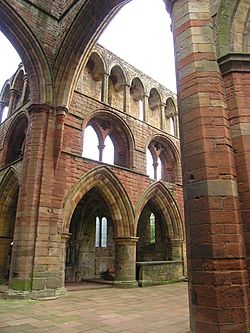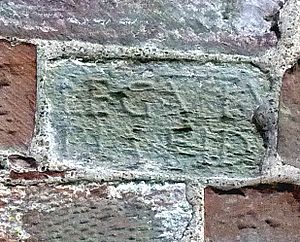Lanercost Priory facts for kids

Lanercost Priory
|
|
| Monastery information | |
|---|---|
| Full name | Lanercost Priory |
| Order | Augustinian |
| Established | Ca. 1169 |
| Disestablished | 1538 |
| Diocese | Carlisle |
| People | |
| Founder(s) | Robert de Vaux |
| Site | |
| Location | Lanercost, Cumbria, England |
| Visible remains | Nave; still used as the parish church, and impressive ruins. West range used as parish rooms |
| Public access | Yes |
Lanercost Priory is an old monastery in Cumbria, England. It was started by a man named Robert de Vaux around 1169. This priory was built for a group of religious people called Augustinian canons.
The priory is located in the village of Lanercost. It's very close to Naworth Castle, and the two places had strong ties. Today, you can visit the priory, as it is looked after by English Heritage.
Contents
The Priory's Beginning
The priory was likely founded in 1169, but records show it could have been any time between 1165 and 1174. It was dedicated to Mary Magdalene, which was quite unusual for the area.
When Robert de Vaux founded the priory, he gave the canons a lot of land. This included the area around Lanercost and several churches. He did this to honor King Henry II and for the well-being of his parents' souls.
Soon after, Robert de Vaux gave the canons the right to choose their own leader. This meant they could elect a new prior when the old one died.
Much of the church building you see today was built in the late 1200s. The builders used stones from the nearby Hadrian's Wall. You can even spot old Roman writings carved into some of these stones!
Royal Visitors and Scottish Raids
Being so close to Scotland meant the priory often faced attacks. This became a big problem during the Wars of Scottish Independence. In 1296, the Scottish army camped at Lanercost. They had already burned other religious places. Luckily, they left before causing too much damage to the priory church.

King Edward I visited Lanercost Priory several times. In 1280, he came with Queen Eleanor. The canons welcomed them warmly. Edward even went hunting nearby.
In 1300, Edward I stayed at the priory again on his way to a castle siege. His last visit was in 1306. He was old and sick, so he traveled in a special horse litter. He stayed for six months, which was a huge strain on the priory's supplies. During his stay, Edward I made decisions about Scottish prisoners.
The king's long visit used up many of the priory's resources. The canons asked him for help in return. Edward I gave them control of some churches, which provided income for the priory. He wrote to the Pope, explaining his generosity was due to his devotion to Mary Magdalene and his long stay. Edward I died shortly after, in 1307.
In 1311, Robert Bruce, the King of Scotland, used the priory as his base for three days. His army caused a lot of trouble and held some canons captive for a short time. Later, in 1328, things improved between the priories of Lanercost and Kelso Abbey in Scotland.
However, in 1346, David II of Scotland attacked the priory. His soldiers damaged the buildings, stole valuables, and broke doors. As late as 1386, one of the priors was captured by the Scots and had to be ransomed.
The priory's wealth changed a lot depending on the border wars. Before the wars started in 1296, the priory was quite rich. But by 1318, its value had dropped almost to nothing because of the constant raids.
Lanercost as a Parish Church
In 1538, King Henry VIII closed down Lanercost Priory. This was part of a big change across England. The priory's buildings lost their roofs, but the church part continued to be used by the local community.
Over time, the church fell into disrepair. In the late 1600s, only a small part of the church was used. The main nave was re-roofed in 1747. However, by 1847, the church was in very bad shape, and its east end roof collapsed.
Thankfully, the church was restored by 1849, thanks to architect Anthony Salvin. More restoration work happened in the 1870s by C. J. Ferguson.
After the priory closed, it was owned by the Dacre family, then later by the Howards. In 1929, the ruins became public property. Today, English Heritage manages them, so people can still visit and learn about its history.
Important Memorials
Lanercost Priory has a special medieval stone carving called the Lanercost Cross. It has an inscription from 1214. The main part of the cross is now kept inside the priory.
In the churchyard, you can find the tomb of Thomas Addison, a famous scientist and doctor. Inside the church, there is a memorial for Reverend Henry Whitehead. He was a vicar here and worked with John Snow on important studies about cholera.
Several members of the Dacre family were buried at the priory in the 1400s and 1500s. These include Humphrey Dacre, 1st Baron Dacre, his wife Mabel, and Thomas Dacre, 2nd Baron Dacre.
Other Burials
- Ralph Dacre, 1st Baron Dacre
- Hugh Dacre, 4th Baron Dacre
- William Dacre, 5th Baron Dacre
- Thomas Dacre, 6th Baron Dacre
- Philippa de Neville
- Thomas Dacre, 2nd Baron Dacre


